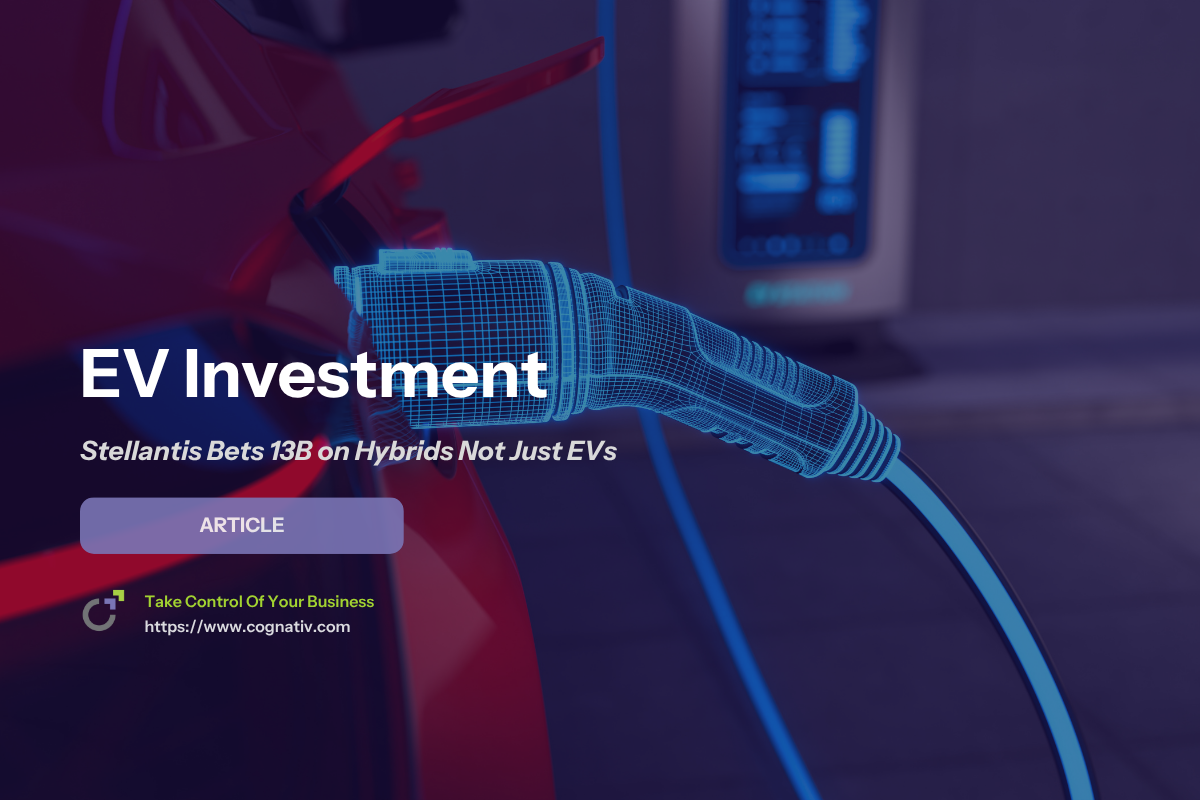

Thursday, October 16, 2025
Kevin Anderson
Stellantis' $13B U.S. EV Investment Plan Shifts Focus Away from Traditional Vehicles
The global auto industry has spent years framing electrification as inevitable and imminent, signaling a transformation of vehicles and transportation options. But Stellantis’s latest announcement — a $13 billion U.S. investment through 2029 — reveals a more nuanced strategy.
Rather than committing the bulk of funds to electric vehicle (EV) programs, Stellantis is prioritizing core manufacturing, hybrid powertrains, and flexible production lines. It’s a deliberate move to give the company more strategic room amid slowing EV demand growth, transportation infrastructure limitations, and shifting policy winds. The investment comes as competitors double down on EV commitments — and could signal a broader recalibration in the industry, particularly for the automotive industry as a whole.
Key Takeaways
-
Stellantis is investing $13 billion in U.S. manufacturing through 2029.
-
EV programs will not be the main beneficiary of this capital.
-
The company is emphasizing flexible manufacturing lines and hybrid platforms.
-
This move contrasts with more aggressive EV expansion plans from GM, Ford, and Tesla.
-
The strategy reflects market uncertainty, not abandonment of electrification.
-
Stellantis' flexible approach delivers value by supporting long-term competitiveness, adaptability, and the ability to respond to evolving market and community needs.

$13 Billion and a Strategic Pivot
Stellantis’ plan focuses on modernizing U.S. manufacturing plants, improving cost structure, and building out hybrid production capacity rather than pushing an accelerated EV rollout. This includes:
-
Upgrading existing facilities and modernizing factories to handle multiple powertrain configurations
-
Expanding production of hybrid and combustion platforms
-
Investing in localized parts, sourcing critical components, and strengthening supply chains
The strategy is less about rejecting EVs than buying time and optionality. In a market where EV adoption is real but uneven, flexibility in adapting operations to changing market demands is becoming a strategic asset.
Why Stellantis Is Adjusting Its EV Roadmap?
Global automakers face a shifting landscape:
-
Softening consumer demand compared to earlier forecasts
-
Lagging infrastructure buildout, particularly in charging
-
Volatile battery supply chains and cost pressures, including challenges related to energy storage and supply
Supply chain volatility is further complicated by competition from countries like China, which plays a major role in battery and component sourcing for the automotive industry.
Instead of locking billions into fixed EV platforms, Stellantis is hedging. It will continue EV production where profitable — but its capital allocation now reflects a more measured timeline for mass electrification.

Reading the Market Signals
The Stellantis decision is less about abandoning EVs and more about reading economic signals early, especially when compared to trends in other industries such as aerospace, electronics, and pharmaceuticals, which have also faced unique challenges and shifts due to technological advancements and globalization. While EV adoption continues to grow, the slope of that growth has changed, reflecting a decline in projected EV adoption rates and forcing automakers to reevaluate timelines and investment allocation.
Stellantis' strategy positions it for success in the long run by adapting to evolving market conditions and learning from the experiences of other industries.
Consumer Demand vs. EV Infrastructure Gaps
For years, U.S. automakers built strategies around rapid, uninterrupted EV adoption curves. But recent consumer data shows:
-
Slowing sales growth outside of early adopter segments
-
Persistent range anxiety in regions with weak charging coverage
-
A widening gap between coastal infrastructure and the interior U.S., highlighting local disparities in charging infrastructure
Many consumers are willing to consider an EV but not yet ready to commit, largely due to:
-
Limited public charging availability and concerns about equitable access for all communities
-
Unpredictable charging times and reliability
-
Higher upfront costs versus ICE and hybrid options
This reality is forcing companies like Stellantis to prioritize flexible manufacturing that can respond to evolving demand rather than betting everything on a single drivetrain technology. Additionally, the growing importance of services—such as charging networks, maintenance, and digital platforms—plays a crucial role in supporting EV adoption and ensuring consumers have the necessary support throughout the transition.
Supply Chain and Battery Constraints
The other major headwind is supply chain volatility. EV production relies heavily on:
-
Critical minerals (lithium, nickel, cobalt) and sourcing raw materials
-
Battery cell and pack manufacturing capacity
-
Complex international logistics
Even with domestic battery investments ramping up, cost volatility remains high, making EV unit economics less predictable than expected. Stellantis’ strategy allows it to expand EV output if conditions improve, with the potential for significantly more EVs produced as supply chain stability increases, but without overcommitting capital prematurely.
This “wait and adapt” posture reflects a more mature phase of the EV market — one where scaling must align with infrastructure and cost realities, not just ambition.
Recently reported data on battery investments highlights the ongoing challenges and opportunities in securing materials and expanding domestic production capacity.

Competitive Landscape and Policy Context
While Stellantis takes a measured approach, peers are doubling down, with leading manufacturers in the EV space accelerating their investments.
General Motors and Ford Motor Company have publicly reaffirmed aggressive EV rollout targets. Tesla, Inc., meanwhile, continues to dominate EV market share in the U.S. with a pure-electric strategy, and its stock performance remains a key indicator for investors tracking the EV sector.
When comparing Stellantis to Toyota, it's notable that Toyota's approach emphasizes both hybrid and fully electric models, reflecting its established presence among legacy manufacturers in the evolving EV industry.
How Stellantis’ Move Differs from GM, Ford and Tesla?
-
GM is committing heavily to battery plants and full EV platforms, targeting rapid market share gains and maintaining its leading position in the U.S. automotive market.
-
Ford is balancing EV bets with selective hybrid expansion, especially for best-selling truck lines.
-
Tesla maintains a single-minded EV strategy, using cost discipline and vertical integration to sustain margins.
Stellantis is charting a fourth path: full electrification eventually, but on a flexible timeline, leaning on hybrid profitability in the near term. This puts the company closer to Toyota’s transitional strategy than to Tesla’s “all-in” model. Company directors play a crucial role in shaping Stellantis' strategic position, approving key decisions that impact its market positioning and long-term competitiveness.
Navigating Policy Uncertainty
Another factor behind Stellantis’ strategy is policy volatility. Subsidy structures, emissions standards, and permitting timelines have become politically charged in the U.S., with various government departments, such as the Department of Commerce, playing key roles in shaping these decisions. Shifting federal priorities — such as potential changes to EV tax credits or manufacturing incentives — make long-term EV planning inherently risky.
By keeping its manufacturing lines flexible, Stellantis is insulating itself from regulatory whiplash while retaining the ability to accelerate if policies stabilize or turn favorable, as the intended purpose of this flexibility is to quickly adapt to evolving market and policy conditions.

Implications for the U.S. Auto Industry
The Stellantis announcement doesn’t just signal a company-specific adjustment — it sends ripples through the entire American automotive ecosystem, including the broader manufacturing industry. How automakers allocate capital affects jobs, businesses, supply chains, labor relations, and the national EV transition timeline, influencing the development of the sector and economic growth.
Labor, Jobs, and Manufacturing Footprint
By focusing its $13 billion investment on manufacturing modernization rather than fully dedicated EV facilities, Stellantis is:
-
Preserving existing labor structures and maintaining positions at legacy plants.
-
Investing in flexible production lines capable of producing internal combustion, hybrid, and EV models.
-
Reducing the need to build new gigafactories from scratch, which shortens time-to-market.
This approach has two effects:
-
Labor stability — UAW-represented plants maintain activity and help preserve manufacturing jobs, rather than facing the uncertainty of rapid EV-only retooling.
-
Incremental transition — workers are retrained gradually, not displaced en masse.
The decision aligns with broader concerns in Washington and state capitals about ensuring a “just transition” for manufacturing communities.
Long-Term Transition vs. Short-Term Strategy
While the decision is framed as tactical, its long-term implications are strategic. Stellantis is betting that:
-
EV adoption will continue, but at a more realistic and possibly declining pace than previous projections.
-
Hybrid platforms will bridge the gap between current demand and future electrification, with projections extending into the next decade.
-
Maintaining manufacturing flexibility gives it a lower risk profile in a volatile policy environment.
This sets Stellantis apart as a strategic hedger, aiming to protect profitability while still positioning itself for eventual electrification. It doesn’t mean EV investment is dead — it means the timeline is being recalibrated to reality. The history of industry transitions shows that adaptability and learning from past patterns are crucial for long-term success.

Final Thoughts — EV Investment Meets Reality Check
The $13 billion Stellantis investment plan is a wake-up call for the industry. After years of EV optimism and hyper-growth forecasts, automakers are now aligning capital with infrastructure and consumer behavior rather than pure ambition.
This strategy reflects a mature understanding of the transition curve:
-
Electrification will happen — but not evenly.
-
Flexible manufacturing offers resilience in a volatile market.
-
Companies that hedge intelligently may emerge stronger when the next acceleration wave hits.
The real story isn’t Stellantis turning away from EVs. It’s Stellantis designing optionality — building a bridge between today’s market realities and tomorrow’s electrified economy.

